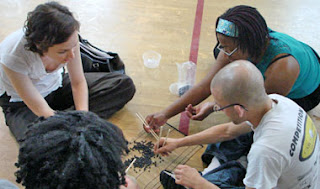
Remember when your teacher used to have "eyes" in the back of her head? Are you growing yours this summer? At Inspired Teaching we consider "observation" to be one of the most important skills a teacher can learn, practice, and develop throughout his or her career.
The ability to really see your students involves much more than simply being able to identify the clothes they're wearing or who they're talking to in the lunch line - but those are still good places to start.
Observing your students ultimately means being keenly aware of what they are doing and why, developing a multi-dimensional picture of their lives both in and outside of school, knowing what they enjoy learning and what presents them with challenge, mapping out the complicated relationships between students and taking the time to understand their complexities. The more complete your observations the better you are able to craft instruction, support, and a classroom community in which every student can succeed.
The legendary "eyes" in the back of teachers' heads come from using all senses to read a room and understand the people in it. Inspired Teachers are constantly watching and listening for new information that will give them a fuller picture of what is happening in their class(es). One teacher we know even had to use his sense of smell to identify a fire that broke out in the back of his room!
It's not too early to begin honing your observation skills. Here are two things you can do this summer to begin exercising your observation muscles, like any muscle they grow stronger the more you practice using them! Please share other exercises you've used or let us know how these work when you try them out by commenting to this blog!
1. Eavesdropping in public - (This exercise is only rude if you let on that you're doing it!) The next time you're at the airport, in a mall, standing in line for movie tickets, riding metro, etc., try listening to the conversations around you. Take in what you hear and then try to figure out what you might learn about the people speaking from their conversations.
Implications for your classroom: You can pick up on a lot by tuning in to your students conversations, for example: you can identify their interests and include those interests in your lessons, and you can learn about outside problems that may be impacting their school experience.
2. Quick Glance Count - When you're in a space with a group of people (your summer classes, the metro, the train platform, the bus, a restaurant, etc.) study them (not rudely) for about 15 seconds and then close your eyes. Think of a characteristic you want to identify, for example: people wearing glasses, people wearing long sleeves, people using computers, people talking on cell phones. Without opening your eyes, see if you can remember how many people share that characteristic. Open your eyes and see how close your memory comes.
Implications for your classroom: Teaching is all about split-second decisions made in response to what's going on around you. If you're reading a passage from a book and look up quickly to notice half the class is asleep - you'll need to change what you're doing to get them involved. As students file in the room rapidly at the first bell you'll watch their body language to gauge the overall mood they'll bring to the beginning of class. Learning to read faces, and bodies, quickly will enable you to adapt your teaching quickly - a secret to classroom management and building community!